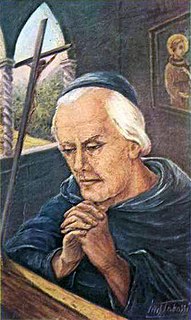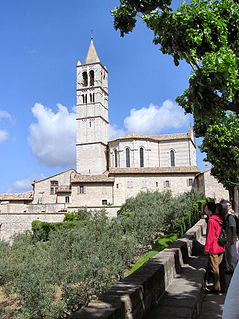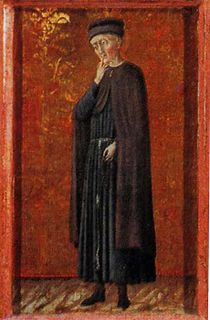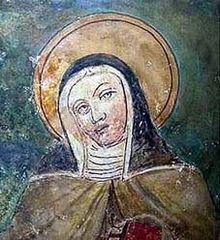Biography
Philippa Mareri was born towards the end of the 12th century into the noble Mareri family, in the family castle at Borgo San Pietro, situated along the road that ran from Assisi to Rome, in the present-day commune of Petrella Salto. Her brother Thomas Mareri held important positions such as that of Mayor of Forlì, and imperial representative in Romagna and Apulia; He was largely responsible for the founding of the city of L'Aquila.
Of prime importance was Philippa’s meeting with Francis of Assisi, who introduced her to the monastic life. Her family tried to prevent this choice, so Philippa fled from home along with some companions and took refuge near Mareri, above the village of Piagge, in what is now called the "Grotto of Saint Filippa", and stayed there about three years, until 1228 when her two brothers gave her the castle with the annexed church of San Pietro de Molito.
Philippa moved in with her companions and lived according to the rule of Saint Francis and Saint Clare of Assisi and the nuns of the Church of San Damiano, Assisi.
The spiritual care of the monastery was entrusted by Francis to Roger Todi.

Giovanni di Pietro di Bernardone, better known as Saint Francis of Assisi, was a mystic Italian Catholic friar, founder of the Franciscans, and one of the most venerated figures in Christianity. In 1223, he arranged for the first Christmas live nativity scene. Pope Gregory IX canonized him on 16 July 1228. Francis later became associated with patronage of animals and the natural environment. It became customary for churches to hold ceremonies blessing animals on his feast day of 4 October.
Assisi is a town and comune of Italy in the Province of Perugia in the Umbria region, on the western flank of Monte Subasio.

Thomas of Celano was an Italian friar of the Franciscans as well as a poet and the author of three hagiographies about Francis of Assisi.

The Poor Clares, officially the Order of Saint Clare – originally referred to as the Order of Poor Ladies, and later the Clarisses, the Minoresses, the Franciscan Clarist Order, and the Second Order of Saint Francis – are members of a contemplative Order of nuns in the Catholic Church. The Poor Clares were the second Franciscan branch of the order to be established. Founded by Saints Clare of Assisi and Francis of Assisi on Palm Sunday in the year 1212, they were organized after the Order of Friars Minor, and before the Third Order of Saint Francis for the laity. As of 2011, there were over 20,000 Poor Clare nuns in over 75 countries throughout the world. They follow several different observances and are organized into federations.
Saint Clare may refer to:

Agnes of Assisi was a younger sister of Clare of Assisi and one of the first abbesses of the Order of Poor Ladies. Pope Benedict XIV canonized her as a saint in 1753.

The Little Flowers of St. Francis is a florilegium, divided into 53 short chapters, on the life of Saint Francis of Assisi that was composed at the end of the 14th century. The anonymous Italian text, almost certainly by a Tuscan author, is a version of the Latin Actus beati Francisci et sociorum eius, of which the earliest extant manuscript is one of 1390 AD. Luke Wadding ascribes the text to Father Ugolino da Santa Maria, whose name occurs three times in the Actus. Most scholars are now agreed that the author was Ugolino Brunforte.
Santa Chiara is Italian for Saint Clare, and may refer to:
Patricia of Naples is an Italian virgin and saint. Tradition states that she was noble; she may have been related to the Roman Emperor. Some sources say that she was a descendant of Constantine the Great. The particulars traditional about her are unreliable and in some instances contradictory.

Vitalis of Assisi, O.S.B. was an Italian hermit and monk.

Bona of Pisa was a member of the Third order of the Augustinian nuns who helped lead travellers on pilgrimages. In 1962, she was canonized a saint in the Catholic Church by Pope John XXIII. She is considered the patron saint of travellers, and specifically couriers, guides, pilgrims, flight attendants, and the city of Pisa.

Angelina of Marsciano, T.O.R. was an Italian Religious Sister and foundress, and is a beata of the Roman Catholic Church. She founded a congregation of Religious Sisters of the Franciscan Third Order Regular, known today as the Franciscan Sisters of Blessed Angelina. She is generally credited with the founding of the Third Order Regular for women, as her religious congregation marked the establishment of the first Franciscan community of women living under the Rule of the Third Order Regular authorized by Pope Nicholas V.

The Basilica of Saint Clare is a church in Assisi, central Italy. It is dedicated to and contains the remains of Saint Clare of Assisi, a follower of Saint Francis of Assisi and founder of the Order of Poor Ladies, known today as the Order of Saint Clare.

Saint Constantius is venerated as a member of the legendary Theban Legion. Similar to the cults of Saint Chiaffredo at Crissolo, Saint Bessus at Val Soana, Saint Tegulus at Ivrea, Saint Magnus at Castelmagno, and Saint Dalmatius at Borgo San Dalmazzo, the cult of Saint Constantius was linked with that of the Theban Legion to lend antiquity to a local saint about whom nothing was really known.

Clare of Assisi was an Italian saint and one of the first followers of Francis of Assisi. She founded the Order of Poor Ladies, a monastic religious order for women in the Franciscan tradition, and wrote their Rule of Life, the first set of monastic guidelines known to have been written by a woman. Following her death, the order she founded was renamed in her honour as the Order of Saint Clare, commonly referred to today as the Poor Clares. Her feast day is on 11 August.

Maria Llorença Requenses Llong was a Spanish Roman Catholic professed religious and the founder of the Capuchin Poor Clares. Llong founded the hospital of "Santa Maria del Popolo" in Naples where she relocated to and which received numerous papal privileges from Pope Leo X and Pope Adrian VI.

Pietro Pettinaio was an Italian Roman Catholic who worked as a comb-maker. He became a professed member of the Third Order of Saint Francis and was well known both for his trade and for his decision to remain in silence while living among the Franciscans. He became known for his charisma and for his care of both the poor and the ill and was honored as a saint during his lifetime by the people of Siena.
Andrea Caccioli was an Italian Roman Catholic priest and a professed member from the Order of Friars Minor. He became the first priest to enter the Franciscans and served as one of the disciples of Francis of Assisi himself - the priest was at his deathbed and attended his canonization. The friar preached across Italian cities such as Rome and Padua as well as in France and he became noted for miracles performed during his lifetime.

The Convento de Santa Clara la Real is a convent of the Poor Clares located in the city of Toledo, Castile-La Mancha, Spain. The present convent was founded in the middle of the 14th century by Toledan noblewoman María Meléndez, and is located near other monasteries of note, such as the monastery of Santo Domingo el Real and the Convent of Capuchins of Toledo.

Santa Lucia is a Baroque-style, former-Roman Catholic church and the adjacent convent is located on Vicolo Santa Lucia #8 in the medieval center of the city of Rieti, region of Lazio, Italy. The church now mainly celebrates Roman Orthodox rites. The convent in 2020 houses the archaeologic collections of the Museo Civici of Rieti.
















